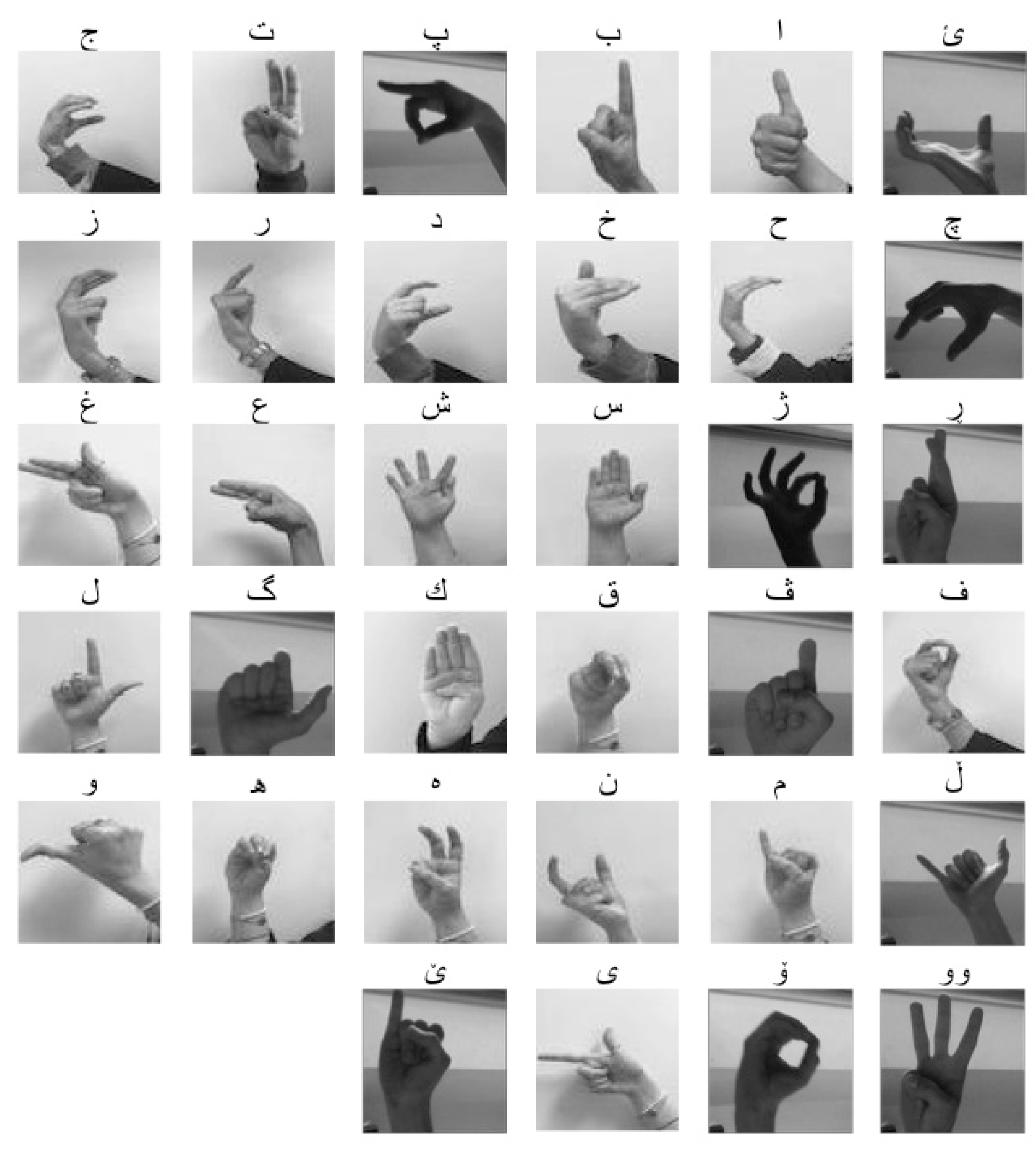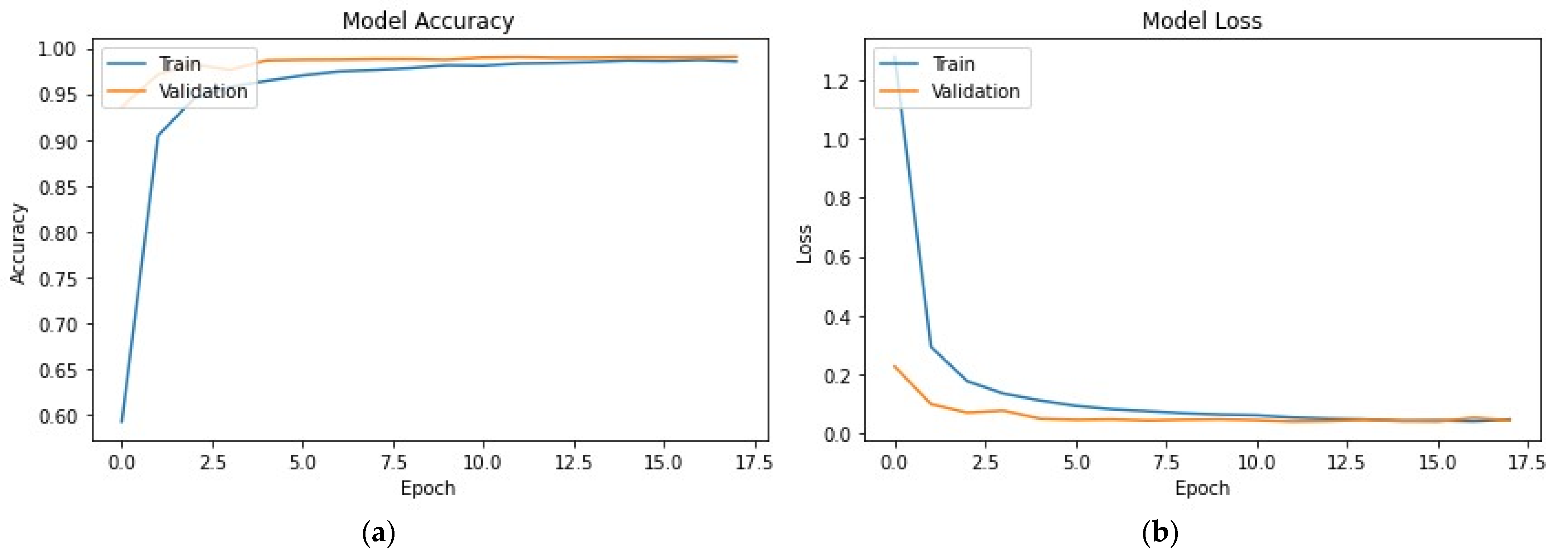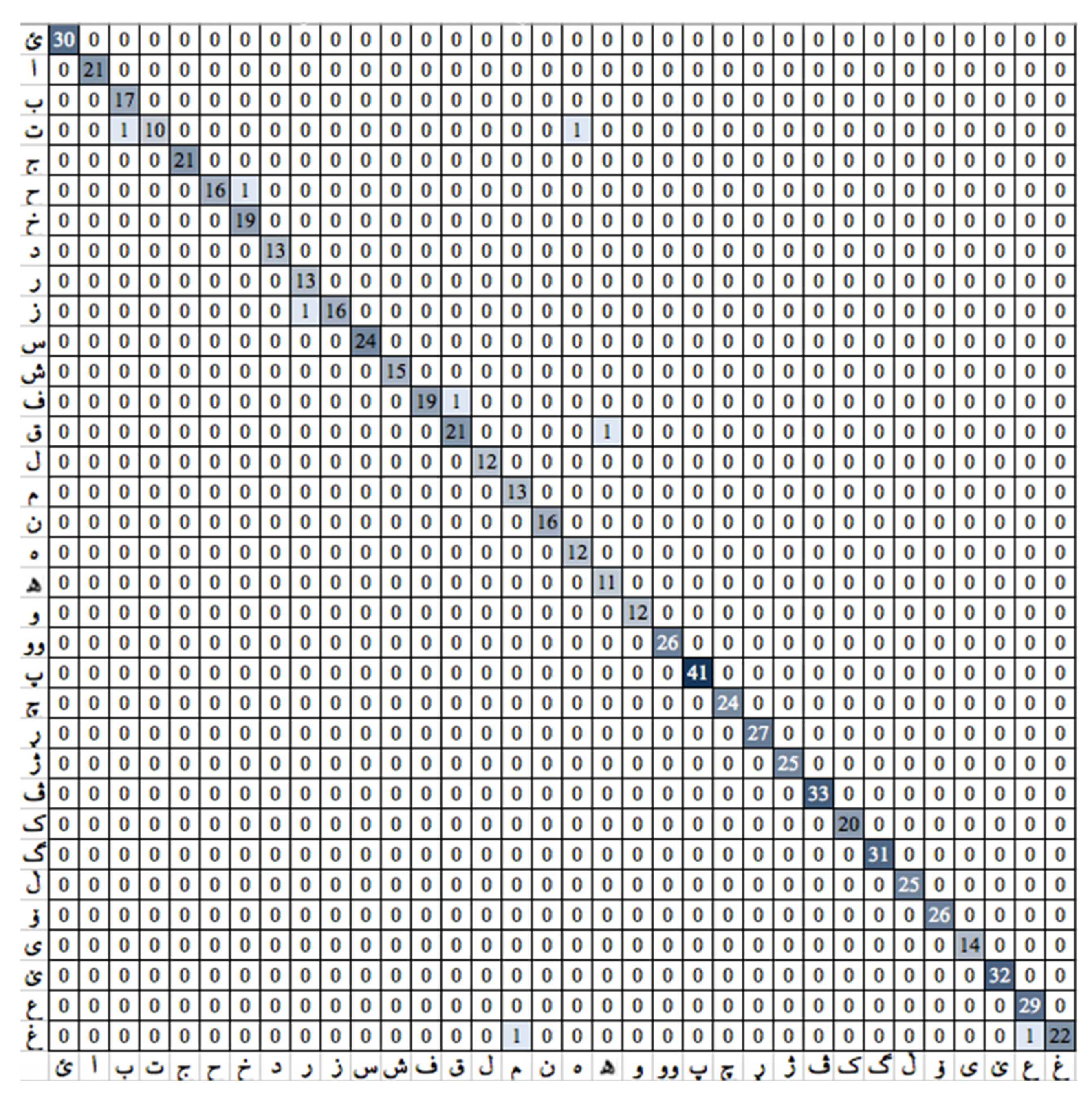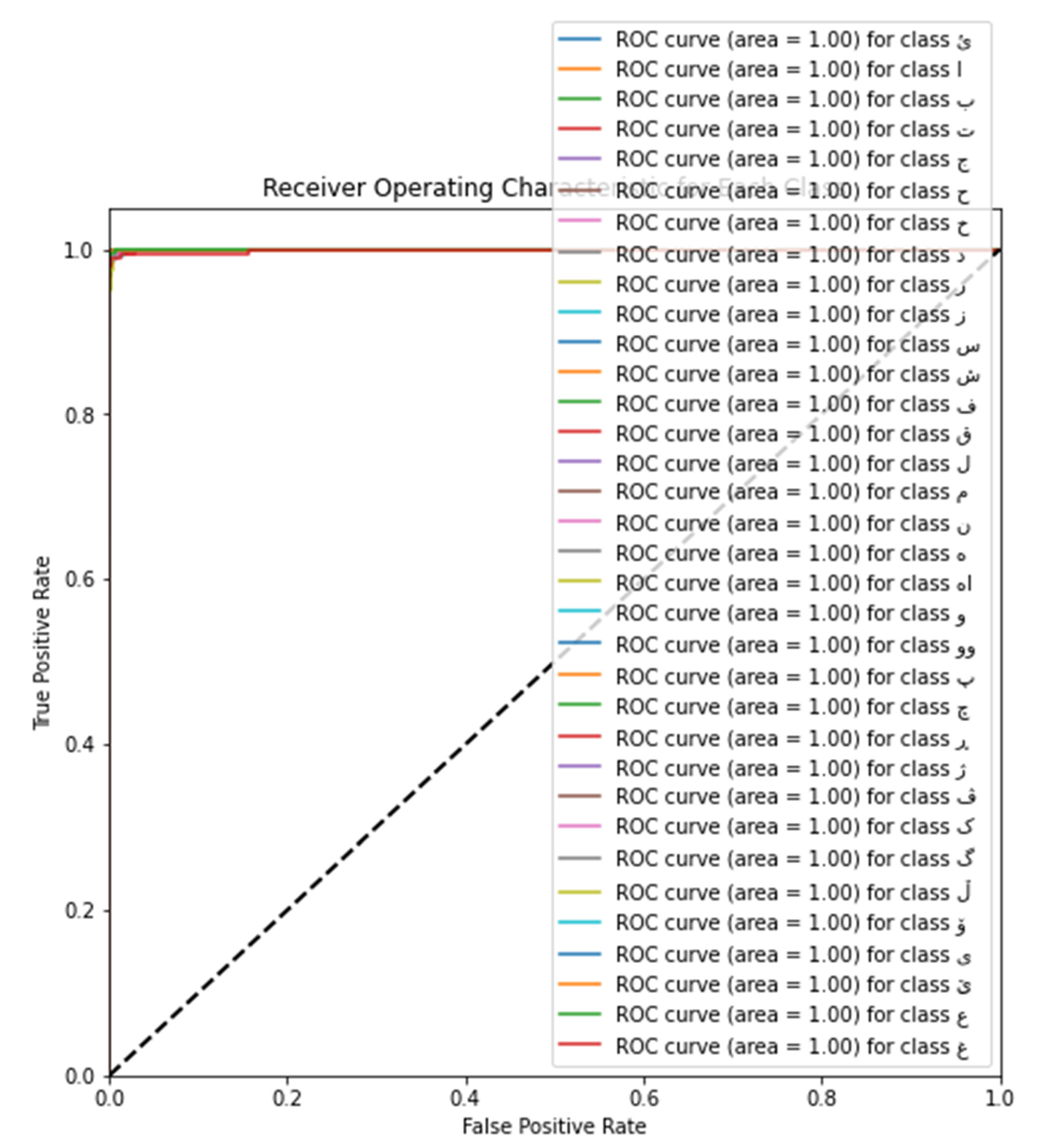Improved Recognition of Kurdish Sign Language Using Modified CNN
Abstract
1. Introduction
1.1. Objectives
1.2. Related Work
1.3. Research Contributions
- The suggested method is the first method for accurately reading Kurdish script using a static hand-shaped symbol.
- We create a completely novel, fully labeled dataset to use with KuSL. The hand form identification dataset collected during ASL and ArSL2018 will be made freely accessible to the scientific community.
- In this method, one-handed forms alone are sufficient for alphabet identification; motion signals are not required.
- This method offers CNN-based real-time KuSL system generation with a high accuracy for several user types.
2. Materials and Methods
2.1. KuSL2023 Dataset
2.2. CNN
3. Results and Discussion
3.1. Test Result
3.2. Discussion
4. Conclusions and Future Work
Author Contributions
Funding
Data Availability Statement
Acknowledgments
Conflicts of Interest
References
- El-Bendary, N.; Zawbaa, H.M.; Daoud, M.S.; Hassanien, A.E.; Nakamatsu, K. ArSLAT: Arabic Sign Language Alphabets Translator. In Proceedings of the 2010 International Conference on Computer Information Systems and Industrial Management Applications (CISIM), Krakow, Poland, 8–10 October 2010; pp. 590–595. [Google Scholar] [CrossRef]
- Maiorana-Basas, M.; Pagliaro, C.M. Technology use among adults who are deaf and hard of hearing: A national survey. J. Deaf Stud. Deaf Educ. 2014, 19, 400–410. [Google Scholar] [CrossRef]
- Rawf, K.M.H.; Mohammed, A.A.; Abdulrahman, A.O.; Abdalla, P.A.; Ghafor, K.J. A Comparative Study Using 2D CNN and Transfer Learning to Detect and Classify Arabic-Script-Based Sign Language. Acta Inform. Malays. 2023, 7, 8–14. [Google Scholar] [CrossRef]
- Rawf, K.M.H.; Abdulrahman, A.O. Microcontroller-based Kurdish understandable and readable digital smart clock. Sci. J. Univ. Zakho 2022, 10, 1–4. [Google Scholar] [CrossRef]
- Deafness and Hearing Loss. 27 February 2023. Available online: https://www.who.int/news-room/fact-sheets/detail/deafness-and-hearing-loss (accessed on 19 January 2024).
- CORDIS. SignON—Sign Language Translation Mobile Application and Open Communications Framework. 20 November 2020. Available online: https://cordis.europa.eu/project/id/101017255 (accessed on 15 December 2023).
- SignDict. What Is SignDict? 1 March 2017. Available online: https://signdict.org/about?locale=en (accessed on 15 December 2023).
- Cormier, K.; Schembri, A.C.; Tyrone, M.E. One hand or two?: Nativisation of fingerspelling in ASL and BANZSL. Sign Lang. Linguist. 2008, 11, 3–44. [Google Scholar] [CrossRef]
- Tao, W.; Leu, M.C.; Yin, Z. American Sign Language alphabet recognition using Convolutional Neural Networks with multiview augmentation and inference fusion. Eng. Appl. Artif. Intell. 2018, 76, 202–213. [Google Scholar] [CrossRef]
- Ye, Y.; Tian, Y.; Huenerfauth, M.; Liu, J. Recognizing American sign language gestures from within continuous videos. In Proceedings of the 2018 IEEE/CVF Conference on Computer Vision and Pattern Recognition Workshops (CVPRW), Salt Lake City, UT, USA, 18–23 June 2018; pp. 2064–2073. [Google Scholar]
- Rivera-Acosta, M.; Ruiz-Varela, J.M.; Ortega-Cisneros, S.; Rivera, J.; Parra-Michel, R.; Mejia-Alvarez, P. Spelling Correction Real-Time American Sign Language Alphabet Translation System Based on YOLO Network and LSTM. Electronics 2021, 10, 1035. [Google Scholar] [CrossRef]
- Ghafoor, K.J.; Rawf, K.M.H.; Abdulrahman, A.O.; Taher, S.H. Kurdish Dialect Recognition using 1D CNN. ARO Sci. J. Koya Univ. 2021, 9, 10–14. [Google Scholar] [CrossRef]
- Lin, C.-J.; Jeng, S.-Y.; Chen, M.-K. Using 2D CNN with Taguchi parametric optimization for lung cancer recognition from CT Images. Appl. Sci. 2020, 10, 2591. [Google Scholar] [CrossRef]
- Mo, T.; Sun, P. Research on key issues of gesture recognition for artificial intelligence. Soft Comput. 2019, 24, 5795–5803. [Google Scholar] [CrossRef]
- Ahmed, M.A.; Zaidan, B.B.; Zaidan, A.A.; Salih, M.M.; bin Lakulu, M.M. A Review on Systems-Based Sensory Gloves for Sign Language Recognition State of the Art between 2007 and 2017. Sensors 2018, 18, 2208. [Google Scholar] [CrossRef]
- Amin, M.S.; Rizvi, S.T.H.; Hossain, M.M. A Comparative Review on Applications of Different Sensors for Sign Language Recognition. J. Imaging 2022, 8, 98. [Google Scholar] [CrossRef] [PubMed]
- Aly, W.; Aly, S.; Almotairi, S. User-Independent American Sign Language Alphabet Recognition Based on Depth Image and PCANet Features. IEEE Access 2019, 7, 123138–123150. [Google Scholar] [CrossRef]
- Tang, A.; Lu, K.; Wang, Y.; Huang, J.; Li, H. A real-time hand posture recognition system using Deep Neural Networks. ACM Trans. Intell. Syst. Technol. 2015, 6, 1–23. [Google Scholar] [CrossRef]
- Taskiran, M.; Killioglu, M.; Kahraman, N. A real-time system for recognition of American sign language by using deep learning. In Proceedings of the 2018 41st IEEE International Conference on Telecommunications and Signal Processing (TSP), Athens, Greece, 4–6 July 2018; pp. 1–5. [Google Scholar]
- MCayamcela, E.M.; Lim, W. Fine-tuning a pre-trained Convolutional Neural Network Model to translate American Sign Language in Real-time. In Proceedings of the 2019 International Conference on Computing, Networking and Communications (ICNC), Honolulu, HI, USA, 18–21 February 2019; pp. 100–104. [Google Scholar] [CrossRef]
- Rioux-Maldague, L.; Giguère, P. Sign Language Fingerspelling Classification from Depth and Color Images Using a Deep Belief Network. In Proceedings of the 2014 Canadian Conference on Computer and Robot Vision, Montreal, QC, Canada, 6–9 May 2014; pp. 92–97. [Google Scholar] [CrossRef]
- Rastgoo, R.; Kiani, K.; Escalera, S. Multi-modal Deep hand sign language recognition in still images using restricted Boltzmann machine. Entropy 2018, 20, 809. [Google Scholar] [CrossRef]
- Nguyen, H.B.D.; Do, H.N. Deep Learning for American Sign Language Fingerspelling Recognition System. In Proceedings of the 2019 26th International Conference on Telecommunications (ICT), Hanoi, Vietnam, 8–10 April 2019; pp. 314–318. [Google Scholar] [CrossRef]
- Li, S.-Z.; Yu, B.; Wu, W.; Su, S.-Z.; Ji, R.-R. Feature learning based on SAE–PCA Network for human gesture recognition in RGBD images. Neurocomputing 2015, 151, 565–573. [Google Scholar] [CrossRef]
- Mazinan, A.H.; Hassanian, J. A Hybrid Object Tracking for Hand Gesture (HOTHG) Approach based on MS-MD and its Application. J. Inf. Syst. Telecommun. (JIST) 2015, 3, 1–10. [Google Scholar]
- Liwicki, S.; Everingham, M. Automatic recognition of fingerspelled words in British Sign Language. In Proceedings of the 2009 IEEE Computer Society Conference on Computer Vision and Pattern Recognition Workshops, Miami, FL, USA, 20–25 June 2009; pp. 50–57. [Google Scholar] [CrossRef]
- Aly, S.; Osman, B.; Aly, W.; Saber, M. Arabic sign language fingerspelling recognition from depth and intensity images. In Proceedings of the 2016 12th International Computer Engineering Conference (ICENCO), Cairo, Egypt, 28–29 December 2016; pp. 99–104. [Google Scholar] [CrossRef]
- Latif, G.; Mohammad, N.; Alghazo, J.; AlKhalaf, R.; AlKhalaf, R. ARASL: Arabic alphabets sign language dataset. Data Brief 2019, 23, 103777. [Google Scholar] [CrossRef]
- Karacı, A.; Akyol, K.; Turut, M.U. Real-time Turkish sign language recognition using Cascade Voting Approach with handcrafted features. Appl. Comput. Syst. 2021, 26, 12–21. [Google Scholar] [CrossRef]
- Aktaş, M.; Gökberk, B.; Akarun, L. Recognizing Non-Manual Signs in Turkish Sign Language. In Proceedings of the 2019 Ninth International Conference on Image Processing Theory, Tools and Applications (IPTA), Istanbul, Turkey, 6–9 November 2019; pp. 1–6. [Google Scholar]
- Karami, A.; Zanj, B.; Sarkaleh, A.K. Persian sign language (PSL) recognition using wavelet transform and neural networks. Expert Syst. Appl. 2011, 38, 2661–2667. [Google Scholar] [CrossRef]
- Khomami, S.A.; Shamekhi, S. Persian sign language recognition using IMU and surface EMG sensors. Measurement 2021, 168, 108471. [Google Scholar] [CrossRef]
- Jalilian, B.; Chalechale, A. Persian Sign Language Recognition Using Radial Distance and Fourier Transform. Int. J. Image Graph. Signal Process. 2014, 6, 40–46. [Google Scholar] [CrossRef][Green Version]
- Ebrahimi, M.; Komeleh, H.E. Rough Sets Theory with Deep Learning for Tracking in Natural Interaction with Deaf. J. Inf. Syst. Telecommun. (JIST) 2022, 10, 39. [Google Scholar] [CrossRef]
- Mariappan, H.M.; Gomathi, V. Real-Time Recognition of Indian Sign Language. In Proceedings of the 2019 International Conference on Computational Intelligence in Data Science (ICCIDS), Chennai, India, 21–23 February 2019; pp. 1–6. [Google Scholar] [CrossRef]
- Rajam, P.S.; Balakrishnan, G. Real time Indian Sign Language Recognition System to aid deaf-dumb people. In Proceedings of the 2011 IEEE 13th International Conference on Communication Technology, Jinan, China, 25–28 September 2011; pp. 737–742. [Google Scholar] [CrossRef]
- Hashim, A.D.; Alizadeh, F. Kurdish Sign Language Recognition System. UKH J. Sci. Eng. 2018, 2, 1–6. [Google Scholar] [CrossRef]
- Mahmood, M.R.; Abdulazeez, A.M.; Orman, Z. Dynamic Hand Gesture Recognition System for Kurdish Sign Language Using Two Lines of Features. In Proceedings of the 2018 International Conference on Advanced Science and Engineering (ICOASE), Duhok, Iraq, 9–11 October 2018; pp. 42–47. [Google Scholar] [CrossRef]
- Mirza, S.F.; Al-Talabani, A.K. Efficient kinect sensor-based Kurdish Sign Language Recognition Using Echo System Network. ARO Sci. J. Koya Univ. 2021, 9, 1–9. [Google Scholar] [CrossRef]
- Urrea, C.; Kern, J.; Navarrete, R. Bioinspired Photoreceptors with Neural Network for Recognition and Classification of Sign Language Gesture. Sensors 2023, 23, 9646. [Google Scholar] [CrossRef]
- Kumar, P.; Roy, P.P.; Dogra, D.P. Independent Bayesian classifier combination based sign language recognition using facial expression. Inf. Sci. 2018, 428, 30–48. [Google Scholar] [CrossRef]
- Achenbach, P.; Laux, S.; Purdack, D.; Müller, P.N.; Göbel, S. Give Me a Sign: Using Data Gloves for Static Hand-Shape Recognition. Sensors 2023, 23, 9847. [Google Scholar] [CrossRef] [PubMed]
- Gu, Y.; Oku, H.; Todoh, M. American Sign Language Recognition and Translation Using Perception Neuron Wearable Inertial Motion Capture System. Sensors 2024, 24, 453. [Google Scholar] [CrossRef] [PubMed]
- SignON Project. SignON Project—Sign Language Translation Mobile Application. 5 July 2021. Available online: https://signon-project.eu/?fbclid=IwAR1xrlxMDPrAdI0gVVJmk1nUtC3f5Otu-pe3NOQEpUbXYV-BWOL7ca4W-Ts (accessed on 15 January 2024).
- Chollet, F.; Omernick, M. Keras Documentation: Working with Preprocessing Layers. Keras. 23 April 2021. Available online: https://keras.io/guides/preprocessing_layers/?fbclid=IwAR3KwRwy6PpRs115ZsnD7GphNZqkhq1svwFSGnUfffDxwdloZ_Na7uiICnk (accessed on 21 February 2023).






| No. | Kurdish Letter | Pronunciation | Taken Symbol | Dataset | No. | Kurdish Letter | Pronunciation | Taken Symbol | Dataset |
|---|---|---|---|---|---|---|---|---|---|
| 1 | ئ | Alif | Space | DB1 | 18 | غ | Ghain | غ | DB2 |
| 2 | ا | Alif * | ا | DB2 | 19 | ف | Fa | ف | DB2 |
| 3 | ب | Ba | ب | DB2 | 20 | ق | Qaf | ق | DB2 |
| 4 | پ | Pa | P | DB1 | 21 | ڤ | Va | X | DB2 |
| 5 | ت | Ta | ت | DB2 | 22 | ك | Kaf | ك | DB2 |
| 6 | ج | Jim | ج | DB2 | 23 | گ | Gaf | T | DB1 |
| 7 | ح | HHa | ح | DB2 | 24 | ل | Lam | ل | DB2 |
| 8 | چ | Cha | Q | DB1 | 25 | ڵ | LLam | Y | DB2 |
| 9 | خ | Xa | خ | DB2 | 26 | م | Mim | م | DB2 |
| 10 | د | Dal | د | DB2 | 27 | ن | Nun | ن | DB2 |
| 11 | ر | Ra | ر | DB2 | 28 |  | Ha |  | DB2 |
| 12 | ڕ | RRa | R | DB1 | 29 | ه | Ha * | ة | DB2 |
| 13 | ز | Za | ز | DB2 | 30 | و | Waw | و | DB2 |
| 14 | ژ | Zha | F | DB1 | 31 | وو | Ww | W | DB1 |
| 15 | س | Sin | س | DB2 | 32 | ۆ | HO | O | DB1 |
| 16 | ش | Shin | ش | DB2 | 33 | ی | Ya | ی | DB2 |
| 17 | ع | Ain | ع | DB2 | 34 | ێ | Ye | I | DB1 |
| Layers | Name | Parameter | Activation Function |
|---|---|---|---|
| 1. | Pre-processing | Rescaling(1./255) | - |
| 2. | Convolution layer 1 | (16, 3, padding = ‘same’) | ReLU |
| 3. | MaxPoolig | - | - |
| 4. | Convolution layer 2 | (32, 3, padding = ‘same’) | ReLU |
| 5. | MaxPoolig | - | - |
| 6. | Dropout | rate= 0.10 | - |
| 7. | Flatten | - | - |
| 8. | Fully connection layer | Dense (256) | ReLU |
| 9. | Fully connection layer | Dense (34) | Softmax |
| 10. | Output layer | loss = sparse_categorical_crossentropy | - |
| No. | Characters | Accuracy% |
|---|---|---|
| 1. | ئ | 100% |
| 2. | ا | 100% |
| 3. | ب | 100% |
| 4. | ت | 91% |
| 5. | س | 100% |
| 6. | ڵ | 100% |
| 7. | ن | 97% |
| 8. | ه | 100% |
| 9. | وو | 100% |
| 10. | ۆ | 100% |
| Average | 98.8% |
| References | Sign Language | No. of Class | Approach | Accuracy (%) | Collected Data |
|---|---|---|---|---|---|
| [17] | ASL | 24 | (User specific and Single) PCANet | 88.70 84.50 | ASL |
| [18] | ASL | 36 | DNN | 98.12 | Captured by Kinect |
| [19] | ASL | 36 | CNN | 98.50 | Collected by Massey University (Massey) |
| [20] | ASL | 26 | CNN(GoogLeNet, and Alexnet) | 95.52 99.39 | ASL |
| [21] | ASL | 26 | DBN (with Known and unknown user) | 99.00 77.90 | Captured by Kinect |
| [22] | ASL | 36 | RBM, CNN | 99.31 | Massey |
| 24 | 97.56 | ASL Fingerspelling | |||
| 36 | 90.01 | NYU | |||
| 24 | 98.13 | ASL Fingerspelling A | |||
| [23] | ASL | 24 | CNN-SVM | 97.08 | Massey |
| CNN | 98.30 | ||||
| [24] | ASL | 26 | SAE-PCANet | 99.00 | ASL |
| [27] | ArSL | 28 | PCANet SVM | 99.50 | Captured by Kinect |
| [29] | TSL | 29 | LR | 91.38 | Captured by LM sensor |
| k-NN | 51.72 | ||||
| RF, | 77.24 | ||||
| DNN | 90.00 | ||||
| ANN | 94.48 | ||||
| Cascade Voting | 98.97 | ||||
| [30] | TSL | 5 | ResNet (CNN) | 78.49 | BosphorusSign |
| [31] | PSL | 32 | (MLP) NN | 94.06 | Captured by digital camera (CDC) |
| [33] | PSL | 32 | Gaussian | 95.62 | CDC |
| [35] | InSL | 13 | FCM | 75.00 | CDC |
| [37] | KuSL | 12 | SIFT | 42.00 | CDC |
| SURF | 42.00 | ||||
| GRIDDING | 67.00 | ||||
| [38] | KuSL | 10 | ANN | 98.00 | Captured from video |
| [39] | KuSL | 84 | RNN | 97.40 | Captured by Kinect |
| Proposed model | KuSL | 34 | CNN | 99.05 | KuSL2023 |
Disclaimer/Publisher’s Note: The statements, opinions and data contained in all publications are solely those of the individual author(s) and contributor(s) and not of MDPI and/or the editor(s). MDPI and/or the editor(s) disclaim responsibility for any injury to people or property resulting from any ideas, methods, instructions or products referred to in the content. |
© 2024 by the authors. Licensee MDPI, Basel, Switzerland. This article is an open access article distributed under the terms and conditions of the Creative Commons Attribution (CC BY) license (https://creativecommons.org/licenses/by/4.0/).
Share and Cite
Hama Rawf, K.M.; Abdulrahman, A.O.; Mohammed, A.A. Improved Recognition of Kurdish Sign Language Using Modified CNN. Computers 2024, 13, 37. https://doi.org/10.3390/computers13020037
Hama Rawf KM, Abdulrahman AO, Mohammed AA. Improved Recognition of Kurdish Sign Language Using Modified CNN. Computers. 2024; 13(2):37. https://doi.org/10.3390/computers13020037
Chicago/Turabian StyleHama Rawf, Karwan Mahdi, Ayub Othman Abdulrahman, and Aree Ali Mohammed. 2024. "Improved Recognition of Kurdish Sign Language Using Modified CNN" Computers 13, no. 2: 37. https://doi.org/10.3390/computers13020037
APA StyleHama Rawf, K. M., Abdulrahman, A. O., & Mohammed, A. A. (2024). Improved Recognition of Kurdish Sign Language Using Modified CNN. Computers, 13(2), 37. https://doi.org/10.3390/computers13020037







